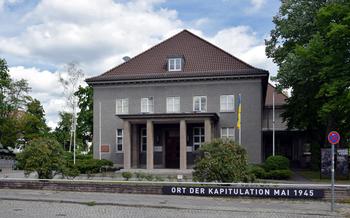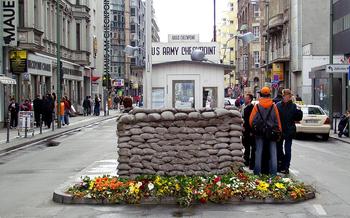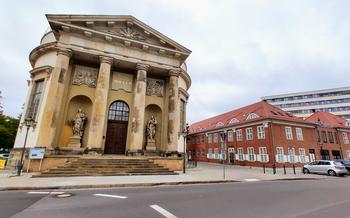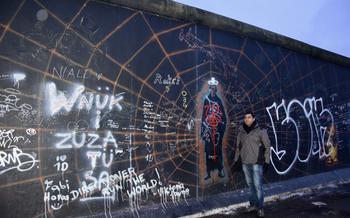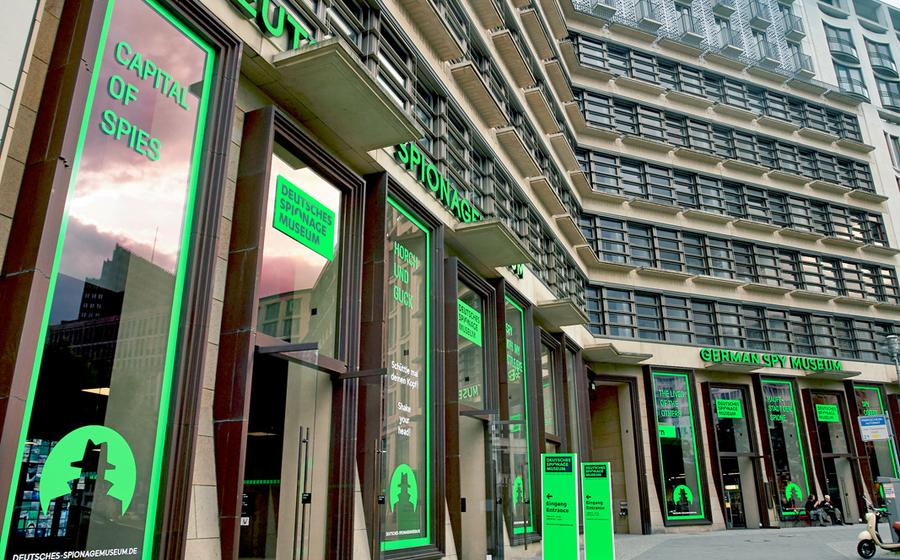
The German Spy Museum
- Orientation and Background
- Understanding Espionage
- Exploring the German Spy Museum
- Cold War Espionage
- Espionage Techniques
- Counterintelligence and Surveillance
- Modern Espionage
- Ethical Considerations
- Espionage in Popular Culture
- Interactive Activities
- Guided Tours
- Insider Tip: Uncovering Hidden Gems
Orientation and Background
Berlin, a city with a rich and complex history, has played a pivotal role in shaping the course of German history. As the nation's capital, it has witnessed significant events and developments, including those related to espionage. Espionage, the act of obtaining secret information, has been an integral part of Berlin's past, leaving an indelible mark on the city's fabric.
Unveiling Berlin's espionage past, the German Spy Museum offers a fascinating journey into the world of secret agents and clandestine operations. Located in the heart of Berlin, the museum is easily accessible by public transportation or on foot. Prepare to delve into the captivating world of espionage, where secrets are whispered, and hidden histories are revealed.
Understanding Espionage
Espionage, the clandestine gathering of information, has played a significant role in shaping the course of history. It involves obtaining secret information from another country or organization without their consent, often through covert operations. Espionage has been practiced since ancient times, with notable examples including the Trojan Horse in Greek mythology and the activities of spies in ancient China.
Throughout history, espionage has been used for various purposes, from gaining military intelligence to uncovering political secrets. It has been employed by governments, military organizations, and even private individuals seeking to gain an advantage over their adversaries. The practice of espionage has evolved over time, with the advent of technology leading to new methods of intelligence gathering, such as electronic surveillance and cyber espionage.
Espionage has been a subject of fascination and intrigue, inspiring countless works of fiction and popular culture. From the iconic James Bond franchise to the real-life exploits of spies like Mata Hari and Kim Philby, espionage has captured the public's imagination. The German Spy Museum in Berlin provides a unique opportunity to delve into the world of espionage, exploring its history, techniques, and impact on international relations.
Exploring the German Spy Museum
The German Spy Museum (Deutsches Spionagemuseum) in Berlin is a treasure trove of interactive exhibits that bring the world of espionage to life. Immerse yourself in the fascinating history of secret agents, codes, and covert operations as you journey through the museum's various thematic zones.
Each zone delves into a different aspect of espionage, from the art of deception to the technology of surveillance. Experience the thrill of deciphering secret codes, marvel at the ingenuity of spy gadgets, and learn about the real-life stories of famous spies who shaped the course of history.
The museum's interactive exhibits allow you to step into the shoes of a secret agent and test your skills in espionage techniques. Try your hand at lock-picking, disguise, and code-breaking challenges, and see if you have what it takes to be a master spy.
With its engaging displays, hands-on activities, and captivating stories, the German Spy Museum offers a thrilling and educational journey into the world of espionage, leaving you with a newfound appreciation for the intricate world of secret agents and their impact on history.
Cold War Espionage
During the Cold War, the rivalry between the East and the West created a fertile ground for espionage activities. The ideological divide between the two blocs led to intense efforts to gather intelligence and gain strategic advantages. Espionage became a vital tool for both sides to monitor each other's military capabilities, political intentions, and technological advancements.
The Cold War era witnessed the rise of advanced espionage technology and surveillance techniques. The development of sophisticated listening devices, code-breaking machines, and satellite imagery allowed intelligence agencies to gather vast amounts of information about their adversaries. The use of spies and double agents also played a crucial role in obtaining sensitive intelligence.
The East German secret police, known as the Stasi, was particularly notorious for its extensive surveillance and counterintelligence operations. The Stasi employed a vast network of informants and agents to monitor the activities of its citizens and suppress any dissent or opposition to the communist regime. The fall of the Berlin Wall in 1989 brought to light the extent of the Stasi's surveillance apparatus and the oppressive methods it used to maintain control.
Espionage Techniques
Espionage involves a range of techniques and methods employed by spies to gather intelligence and carry out their missions effectively. These techniques have evolved over time, adapting to changing technologies and geopolitical landscapes.
Tradecraft is a term used to describe the skills and methods specific to espionage. It encompasses various techniques, including surveillance, code-breaking, and clandestine communication. Spies are trained in tradecraft to operate effectively in hostile environments and avoid detection.
Disguise and Deception play a crucial role in espionage operations. Spies often adopt false identities, use aliases, and employ various disguises to blend in with their surroundings. They may also use deception tactics, such as creating false documents or spreading misinformation, to gain access to sensitive information or manipulate situations to their advantage.
Counterintelligence and Surveillance
Countering espionage activities is a crucial aspect of national security. Governments employ various measures to protect their secrets and prevent foreign intelligence agencies from obtaining sensitive information. One key strategy is counterintelligence, which involves gathering information about potential spies and their activities. This can be done through surveillance, interrogation, and other techniques.
Surveillance plays a vital role in counterintelligence and espionage. Intelligence agencies use a range of methods to monitor potential spies, including physical surveillance, electronic surveillance, and human intelligence. Physical surveillance involves observing suspects in person, often using covert techniques to avoid detection. Electronic surveillance includes intercepting communications, such as phone calls and emails, and monitoring internet activity. Human intelligence involves recruiting informants and undercover agents to gather information from within enemy organizations.
The effectiveness of counterintelligence and surveillance operations depends on the skills and training of the personnel involved. Intelligence agencies invest heavily in training their officers in surveillance techniques, interrogation methods, and other aspects of counterintelligence. They also collaborate with other agencies, both domestically and internationally, to share information and coordinate efforts.
Modern Espionage
Espionage has evolved dramatically in the digital age, with technology playing a crucial role in the way intelligence is gathered and analyzed. Cyber warfare and data mining have become essential tools for modern spies, allowing them to infiltrate networks, steal sensitive information, and disrupt enemy operations. Social media platforms and the vast amounts of data generated by internet activity have created new opportunities for intelligence agencies to collect information on individuals and groups.
The proliferation of technology has also led to new challenges for intelligence agencies. The sheer volume of data available makes it difficult to sift through and identify relevant information. The increasing use of encryption and other security measures has made it harder for spies to intercept communications and access sensitive data. Additionally, the growing awareness of privacy issues has led to increased scrutiny of intelligence agencies' activities, making it more difficult for them to operate in secret.
Ethical Considerations
Espionage raises complex ethical questions that grapple with the balance between national security and individual privacy. The acquisition of intelligence often involves covert actions that may infringe upon personal freedoms and civil liberties. Governments must carefully consider the justification for such actions and ensure that they are proportionate and necessary.
The potential benefits of espionage, such as preventing terrorist attacks or uncovering criminal networks, must be weighed against the potential harms, such as the violation of privacy and the erosion of trust between citizens and their governments. Striking the right balance is a continuous challenge, particularly in an era of rapidly evolving technology.
Transparency and accountability are crucial in ensuring that espionage activities are conducted ethically. Governments should provide clear guidelines and oversight mechanisms to regulate the use of surveillance and intelligence-gathering techniques. Independent bodies, such as privacy commissions, can play a vital role in monitoring and investigating potential abuses of power.
In the digital age, the ethical implications of espionage have become even more complex. The vast amount of personal data generated and stored online presents new challenges and opportunities for intelligence agencies. Balancing the need for security with the protection of privacy requires careful consideration and ongoing debate.
Espionage in Popular Culture
Espionage has long captivated the public imagination, inspiring countless works of fiction and nonfiction. From the thrilling spy novels of Ian Fleming to the action-packed films of the James Bond franchise, espionage has become a staple of popular culture. These portrayals often depict the world of spies as glamorous and exciting, filled with intrigue, adventure, and danger. However, they also raise important questions about the ethics and consequences of espionage, as well as its impact on international relations and national security.
The portrayal of espionage in popular culture has had a profound impact on public perception. Spy novels and films have helped to shape the way we think about spies and their work, often romanticizing the profession and making it seem more exciting and glamorous than it may actually be. This can lead to unrealistic expectations about the role of espionage in the real world, as well as a lack of understanding about the risks and sacrifices that spies often make.
Despite the fictionalized nature of many spy stories, they can also provide valuable insights into the real world of espionage. By exploring the challenges and moral dilemmas faced by fictional spies, these works can help us to better understand the complex and often dangerous world of intelligence gathering. Ultimately, the portrayal of espionage in popular culture is a reflection of our own fascination with the secret world of spies and the role they play in shaping our world.
Interactive Activities
The German Spy Museum offers a range of interactive activities that allow visitors to experience espionage firsthand. The museum's highlight is its role-playing simulations, which provide a unique opportunity to step into the shoes of a secret agent. These simulations challenge visitors to solve puzzles, decipher codes, and navigate surveillance cameras, giving them a glimpse into the thrilling and complex world of espionage.
In addition, the museum features numerous interactive exhibits that allow visitors to handle and learn about various spy gadgets. These exhibits showcase the ingenuity and creativity of spies throughout history, from hidden cameras disguised as everyday objects to sophisticated eavesdropping devices. Visitors can try their hand at lock-picking, test their code-breaking skills, and even create their own secret messages using invisible ink.
Guided Tours
The German Spy Museum offers guided tours for groups of all sizes, providing a more in-depth exploration of the museum's exhibits. These tours are led by experienced guides who share fascinating insights and stories about the world of espionage. They delve deeper into the historical events, famous spy cases, and espionage techniques presented in the museum, offering a comprehensive understanding of the subject.
For those who prefer a more personalized experience, audio guides are available in multiple languages. These guides allow visitors to explore the museum at their own pace, choosing which exhibits to focus on and listening to detailed commentary and explanations. The audio guides provide a wealth of information, making the museum accessible to visitors of all levels of knowledge about espionage.
Insider Tip: Be sure to check the museum's website or inquire at the information desk about upcoming special events, workshops, or lectures. These events often feature guest speakers, experts in the field of espionage, who share their knowledge and experiences, offering a unique opportunity to learn more about the fascinating world of spies.
Insider Tip: Uncovering Hidden Gems
Beyond the main exhibits, the German Spy Museum holds a treasure trove of hidden gems waiting to be discovered by curious visitors. One such gem is the "Secret Room", tucked away in a secluded corner of the museum. This inconspicuous room houses a collection of rare and fascinating artifacts that provide a glimpse into the world of espionage beyond the well-known stories.
From decoded messages to ingenious spy gadgets and personal belongings of legendary spies, the Secret Room offers a unique opportunity to explore the lesser-known aspects of espionage history. Visitors can marvel at the intricate designs of secret writing devices, handle replicas of iconic spy tools, and delve into the lives of individuals whose covert actions shaped the course of history.
This hidden gem is a testament to the museum's commitment to preserving and showcasing the diverse and captivating world of espionage. By venturing into the Secret Room, visitors can gain a deeper understanding of the complexities, challenges, and triumphs that define the realm of spies and their impact on our world.



